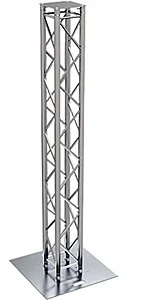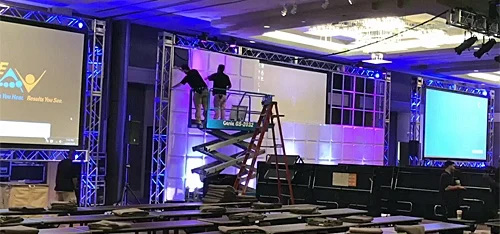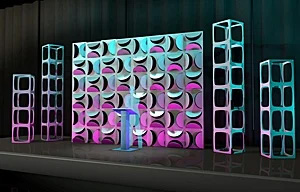The stage is often seen as the centerpiece of the evening, and there is any number of ways to create the aesthetic you’re looking for. From hard sets to soft, and ranging in production level from bat mitzvahs to the Grammy’s – your stage design can be as unique as your event. If you haven’t already, we recommend going back to read our first installment of the backdrops series: Colored Drape.
But if you’re in need of a backdrop beyond just pipe & drape, and your budget isn’t open ended, then there are few staples that deserve your consideration. In this installment, we’ll look at modular set design elements.
As the name suggests, this type of set design revolves around solid, modular pieces constructed of various materials, and varying in both general shape and texture. The pieces can be mixed and matched to create a unique pattern, or composed entirely of a singular piece repeated to create one cohesive, solid look. These types of modular elements are typically constructed in one of three ways – they can be hung from pipe and drape, hung from truss, or standalone.
Hung from Pipe & Drape
 There are a few types of modular set pieces that are lightweight enough that they can be simply hung from pipe and drape. This could be considered the base-line option in terms of cost and scale, as it’s really only a marginal increase vs. pipe and drape alone. The modular pieces can be solid or revolve around cutouts to create the design, but they are generally square pieces ranging from 1’ to 3’ that are all connected together via pins in each corner. This allows the pieces to look and behave like a unified design, without having to spend the time that building a hard set requires, or with the weight of a framework to hold them in place. However, be sure to ask how high these sets can go. Since they’re hanging from pipe and drape, you must not overload the crossbar for risk of it bowing under the weight. For that reason, most types of modular set pieces that hang from drape will recommend a height limit. Thankfully, most offer at least 12’ to 15’ of set height, which is enough in many cases.
There are a few types of modular set pieces that are lightweight enough that they can be simply hung from pipe and drape. This could be considered the base-line option in terms of cost and scale, as it’s really only a marginal increase vs. pipe and drape alone. The modular pieces can be solid or revolve around cutouts to create the design, but they are generally square pieces ranging from 1’ to 3’ that are all connected together via pins in each corner. This allows the pieces to look and behave like a unified design, without having to spend the time that building a hard set requires, or with the weight of a framework to hold them in place. However, be sure to ask how high these sets can go. Since they’re hanging from pipe and drape, you must not overload the crossbar for risk of it bowing under the weight. For that reason, most types of modular set pieces that hang from drape will recommend a height limit. Thankfully, most offer at least 12’ to 15’ of set height, which is enough in many cases.
Hung from Truss
 A step up from the pipe and drape-based modular design, there are those that require a more rigid support system. There is typically a frame in which the modular pieces fit, and truss generally serves as the support. If you’re not familiar, truss, in the context of AV, are metallic, column-like structures that serve as framework for building (pictured to the left). It can either be used as vertical, or horizontal support; or in the case of heavier modular set design elements, as both. This allows for creating sturdier, more elaborate set designs, without worrying about the limitations on height and weight that a simple crossbar is more susceptible to. With these types of elements, you’ll have the ability to create more visually impactful sets, which can easily expand to create unified screen surrounds, and even offer options for printing custom branding or sponsor signage. While the price points of these types of elements are generally higher than the drape-hung versions by themselves, be mindful that it will also require more time to build considering the frame and the truss, and the labor hours will follow.
A step up from the pipe and drape-based modular design, there are those that require a more rigid support system. There is typically a frame in which the modular pieces fit, and truss generally serves as the support. If you’re not familiar, truss, in the context of AV, are metallic, column-like structures that serve as framework for building (pictured to the left). It can either be used as vertical, or horizontal support; or in the case of heavier modular set design elements, as both. This allows for creating sturdier, more elaborate set designs, without worrying about the limitations on height and weight that a simple crossbar is more susceptible to. With these types of elements, you’ll have the ability to create more visually impactful sets, which can easily expand to create unified screen surrounds, and even offer options for printing custom branding or sponsor signage. While the price points of these types of elements are generally higher than the drape-hung versions by themselves, be mindful that it will also require more time to build considering the frame and the truss, and the labor hours will follow.

Freestanding
Lastly, and arguably the outlier, freestanding modular elements can exist both as the crux of your backdrop, as well as accents to the others.
 As the focal point, some modular scenic elements have vertical rigidity built in, and just rely on a certain amount of depth to provide support. Of course, these elements often require some sandbagging to secure in place, but should take much less time to set than needed to hang. These freestanding elements can also be used to frame your set, as vertical decorative columns that add texture and depth to your stage, and serve as an opportunity to enhance your lighting design.
As the focal point, some modular scenic elements have vertical rigidity built in, and just rely on a certain amount of depth to provide support. Of course, these elements often require some sandbagging to secure in place, but should take much less time to set than needed to hang. These freestanding elements can also be used to frame your set, as vertical decorative columns that add texture and depth to your stage, and serve as an opportunity to enhance your lighting design.
Not all modular freestanding elements are generally square either. They can come in various shapes and designs – they aren’t limited to what can be easily hung together.
Of course, one of the best parts of the modular concept is the near endless number of possibilities and combinations that exist. Think about using multiple forms of modular pieces as a way to create a totally unique set design. Get creative!


